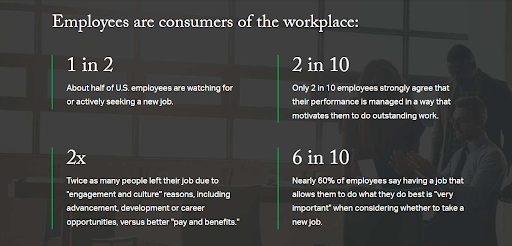Low Employee Engagement Scores - How to Move the Needle
HR professionals rely on engagement scores and surveys to gain insights into the state of their employees' work lives. And in a field where numbers aren’t always easy to come by, it’s easy to get fixated on the ones you do have. But the problem with getting hyperfocused on scores on their own is that it can distract from action.
Action is especially important when you have low employee engagement scores.
We all agree that engaged employees create better customer experiences. But when confronted with low employee engagement scores—even if only in one or two dimensions—there is a common trap that HR leaders fall into: getting stuck in analysis paralysis, rather than quickly putting energy into the tangible actions that matter most.
For instance, does your business provide growth opportunities? Gallup research suggests that 59% of millennials say they find development opportunities extremely important when applying for positions. Furthermore, about half of U.S. employees are actively looking for a new job due to an unsatisfying employee experience!
Source: Gallup: Employee Experience
If you want to truly improve low employee engagement scores, you need to look past the scores – and focus on action. In this article, we look at what it means to balance measurement and action, walking you through how and when to apply the most common remediations.
Data Is Just the Beginning: Balancing Measurement and Action
Conventional HR wisdom suggests that collecting employee engagement scores is one part of a lengthy annual process including:
Surveying your employee base
Analyzing the data to find out what’s actually happening
Responding to those results via the annual planning and budgeting process
That’s way too long between asking for feedback and demonstrating a response for today’s workforce. The reality is that you already have a sense of employee engagement from prior results and your own lived experience and you should already have some plans in mind.
And don’t forget—accurately measuring employee engagement requires thinking beyond tests and surveys. Successful businesses push past traditional approaches to flip the status quo. Let’s break it down further.
Over-Analyzing vs. Quick Action
Here's a common scenario: an organization initiates something like a clandestine "engagement taskforce" without informing employees. It results in endless discussions, analysis paralysis, and a lack of concrete action. Employees, on the other hand, perceive this inaction as indifference, further dampening their engagement.
PILOT advocates for a dynamic shift. It’s time to acknowledge that you already know where engagement lags before you get low employee engagement scores. Instead of investing excessive energy in gathering more data, focus on addressing the issues.
In our nine years of being solely focused on developing talent we've come to learn that one actionable way to fix your low engagement scores is group coaching. Our approach helps foster an employee mindset to own their careers, and we’ve seen results that 80% of those that participate in our program intend to stay with their employer for two years vs. the industry average of 60%.
Further, effective engagement strategies must include quick, high-impact initiatives that deliver tangible results. Outsourcing to a partner like PILOT is going to be much, much faster than trying to develop it within your organization. By concentrating on initiatives that can be swiftly implemented, organizations can make visible progress in a short timeframe.
Real Talk About Low Employee Engagement Scores
The truth is, you likely already know where your low scores are going to come from. You shouldn’t wait for a deep-dive analysis of the annual engagement survey results to act. The signs are often there in plain sight. Low morale, decreased productivity, increased turnover—these are all red flags. And waiting to conduct and analyze a survey is setting you back from taking real actions that matter.
But even when HR leaders get ready to take action, there’s another problem we commonly see: focusing too much energy on long-term, complex, resource-intensive projects that may never even successfully grow legs. Instead, leaders should prioritize “quick win” initiatives that will have a high impact.
Focusing on higher impact, lower effort initiatives is the key to truly moving the needle on employee engagement.
Image credit: ProductPlan
For example, if you know that communication between managers and employees is a gap in your organization, don’t embark on a months-long journey of developing intricate communication training programs or deploying extensive internal studies.
A quick win might be as simple as establishing informal “coffee chats” between employees and managers to foster open communication and address concerns in real-time.
So, How Do You Move the Needle on Low Employee Engagement Scores?
Leading HR consultancy Mercer has valuable insights into the correlation between asking employees about their engagement and taking meaningful actions. The data indicates that merely surveying employees without subsequent actions can be detrimental. In fact, it might be worse than not asking about their experience at all.
“Nothing will boost engagement more than asking someone what they need. Nothing will kill it quicker than not acting on what they said!”
Gethin Nadin, Bestselling HR Author
It’s a compelling case for organizations to focus on actionable engagement strategies rather than just soliciting feedback.
Action #1: Plan, then Communicate
Start with creating a short-term action plan before you get the data. The data will seldom change, and often it confirms what you already knew. We’ve seen success with HR leaders who do not wait for data, but instead have the data validate their course of action.
Once you have a plan that won’t take years to complete, make sure to communicate the insights from the data to your organization. Avoid data dumping, and instead tease out the insights to get traction internally.
It’s not enough to implement strategies and hope employees notice the improvements. Regular, transparent communication ensures that employees are aware of the changes, understand the organization’s commitment to their well-being, and can see the impact on their work lives. Again, employees need to know that their voices are heard and action is being taken!
Further, research suggests that workers who receive feedback from their boss three times per month tend to have very positive feelings about their relationship with their managers. Simply increasing those communication touchpoints can increase engagement.
Action #2: Prioritize Which Low Engagement Scores You Want to Improve
While you might want to improve all of them, don’t bite off more than you can chew. Start by identifying the first three low engagement score survey categories you want to impact in the next two years. To get started, consider these questions:
Which scores matter most to your organization?
Which ones are the easiest to move?
Which link to your business strategy?
Which are the lowest?
Which dropped the most?
Which are furthest from your benchmarks?
By prioritizing and taking action on engagement initiatives, rather than overanalyzing data, HR leaders can take meaningful steps to enhance the work environment and build momentum toward a more engaged workforce.
Improving Low Employee Engagement Scores Requires a Holistic Approach
How do you move the needle on low employee engagement scores? It’s not about endlessly crunching numbers or drowning in surveys.
Instead, it’s time to stop obsessing over measuring and start taking meaningful actions. This means that action can be taken now. You don’t need to wait for survey results to come back in a few months to fix a problem.
PILOT offers a fresh approach that empowers your workforce with actionable strategies. Our program avoids organizational paralysis and fosters a more engaged, motivated team. We challenge you to challenge conventional HR beliefs, and you’ll find a path to higher engagement scores and a more motivated, productive workforce.


